NAZARETH
“In the sixth month, the angel Gabriel was sent from God to a town of Galilee called Nazareth, to a virgin betrothed to a man named Joseph, of the house of David, and the virgin’s name was Mary.” (Luke 1:26-27)
We begin in Nazareth which is best known for being the site of the Annunciation and the home village of Mary, which the Gospel of Luke tells us. According to the Gospel of Matthew, Joseph and Mary resettled in Nazareth after returning from the flight from Bethlehem to Egypt, and according to the New Testament, Jesus grew up in Nazareth from some point in his childhood.

Nazareth is a town in southern Galilee about 15 miles southwest of the Sea of Galilee and 20 miles from the Mediterranean in the basin of the hills of lower Galilee.
There are two churches in Nazareth that claim to be built on the site of Mary’s home: The Greek Orthodox Church and Well of St. Gabriel and the Latin Rite Basilica of the Annunciation.
The Greek Orthodox base their tradition on the statement of the Proto-gospel of James that says that Mary was greeted by the angel when she fetched water from the well.
The second church is the large Roman Catholic Basilica of the Annunciation in the Custody of the Holy Land Franciscan Friars. The present church was built from 1954 to 1969 and incorporated the ruins of many centuries. It was designed by the Italian architect, Giovanni Muzio.
The massive two-story basilica, in strikingly modern architectural style and colorfully decorated, became the largest Christian church in the Middle East when it was completed in 1969. It contains two churches, the upper one being the parish church for the Catholic community of Nazareth. Their language is Arabic. The lower church, simple in form, is for the use of pilgrim groups.

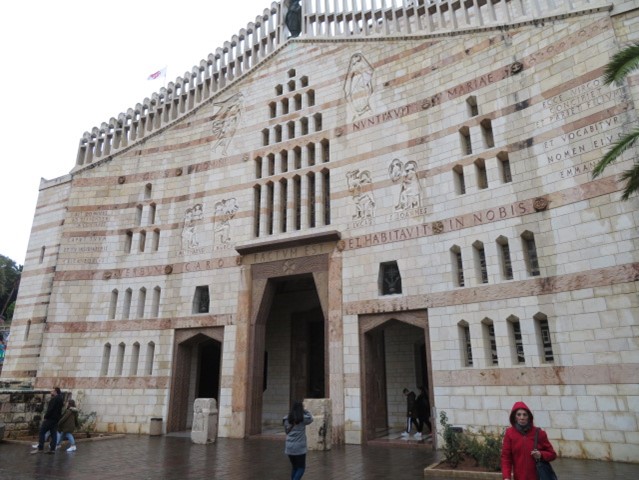
(left photo: wiki: Church from the north side; right photo: SMRP; Church from west)
Its cupola, which dominates modern-day Nazareth, is surmounted by a lantern symbolizing the Light of the World.
The cupola itself represents an inverted lily opening its petals to the shrine below. The lily is the symbol of Mary’s purity.
The shape of the basilica is supposed to resemble a giant tent. For it is here that the “Word was made flesh and dwelt (literally ‘pitched His tent’ in the original Greek) among us” (John 1:14). In fact, these words are carved in Latin across the façade of the basilica. Also on the cream limestone façade are reliefs of Mary, Gabriel and the four evangelists, Matthew, Mark, Luke and John. At the very top and center of the facade is a bronze statue of Jesus.
Let us go inside the church from the entrance gate. Here we come upon the lower level of the basilica. In the center, we see the sunken grotto that contains the cave-home of the Virgin Mary. Of course this is the main site of the basilica. For this reason, the cave is flanked by remnants of earlier churches on the site. The entrance to the cave is usually protected by a grill. Inside the grill is an altar which contains a very powerful inscription that poignantly inserts the word “here” to the solemn line of the Angelus: “And the Word was made flesh here.” This is where the infinite entered time. This is where God became man!!! This is holy ground!!!
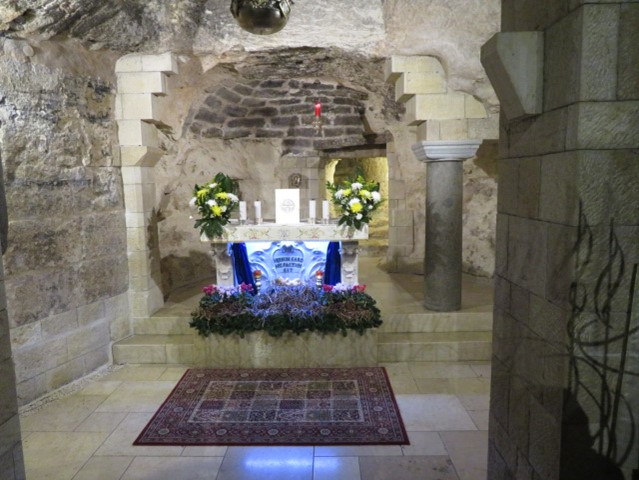
(photo: SMRP: Scene of the Annunciation)
Let us stop here and recite the Angelus prayer.
- The Angel of the Lord declared unto Mary.
- And she conceived of the Holy Spirit.
Hail Mary…
- Behold the handmaid of the Lord.
- Be it done unto me according to thy Word.
Hail Mary…
- And the Word was made flesh.
- And dwelt among us.
Hail Mary…
- Pray for us, O Holy Mother of God.
- That we may be made worthy of the promises of Christ.
Hail Mary…
Let us pray: Pour forth, we beseech thee, O Lord, thy grace into our hearts, that we to whom the incarnation of Christ, Thy Son, was made known by the message of an angel, may by His Passion and Cross be brought to the glory of His resurrection, through the same Christ Our Lord. Amen.
Origin of the Angelus: As with many Catholic prayers, the name “Angelus” (Latin for Angel) is derived from the first word of the prayer: “The Angel of the Lord declared unto Mary…” The history of the Angelus is a combination of what we know as certain and what has been given according to tradition. We are certain that Franciscan houses and churches were praying the Angelus by 1263. We possess the liturgical texts, prepared by Fra Sinigardi di Arezzo (1190-1282), that were in use in the 13th century. What is not certain is the origin of the prayer.
From 1220 to1221, St. Francis went to Egypt, the Holy Land, and other Muslim-held lands. He was impressed by the very public noontime call to prayer for all people. While the noontime call to prayer was already in practice in the monasteries of Europe, it was not a practice among the people. The Angelus sprang from St. Francis’ attention to the Incarnation, his love of Mary, the Mother of God, and a desire to ensure that prayer entered the daily lives of all people (Franciscans, Sacred Heart Church, Tampa, Fla).
The Angelus is also based on the 11th century monastic custom of reciting three Hail Marys during the evening bell. In earlier times, the resurrection of Christ was commemorated in the morning; His suffering at noon; and the Annunciation in the evening. St. Bonaventure, in 1269, encouraged the faithful to adopt the custom of the Franciscans of praying three Hail Marys as the evening bell was rung.
By the 17th century, the prayer had a set pattern. When the church bells were rung at 6 a.m., noon, and 6 p.m., short verses from Scripture were recited, each having to do with the Incarnation, each followed by a Hail Mary, and then a closing prayer (Franciscans, ibid.).
Ascending the stairs, we arrive at the upper basilica, which is quite modern. It is the parish church for the Catholics of Nazareth. Around the walls of the upper church are colorful representations of the Virgin Mary in various materials, presented by many countries. Behind the main altar is a huge mosaic depicting the “one, holy, catholic, and apostolic church.” It may well be one of the largest mosaics in the world.
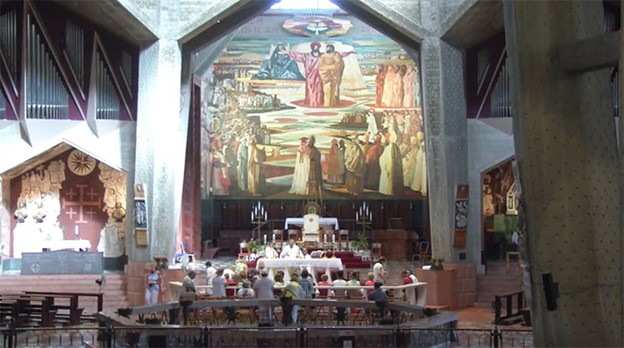
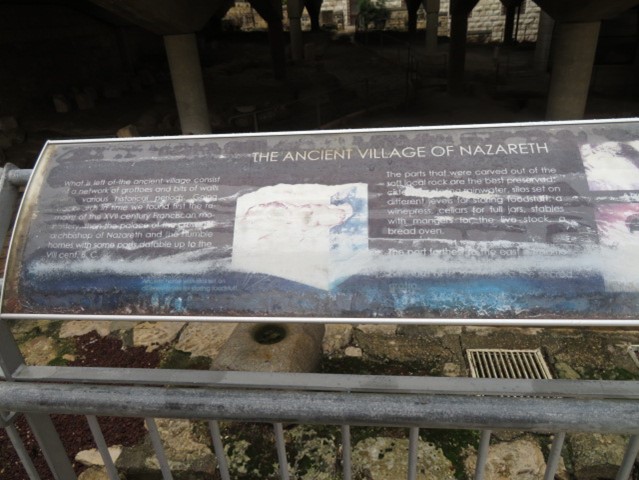
(top photo: cmc-terrasanta.com; bottom photo: SMRP)
Going now through the left side exit, we enter a large courtyard that overlooks many first century remains of Nazareth at the time of Jesus. There are silos, cisterns, oil presses, and house foundations.
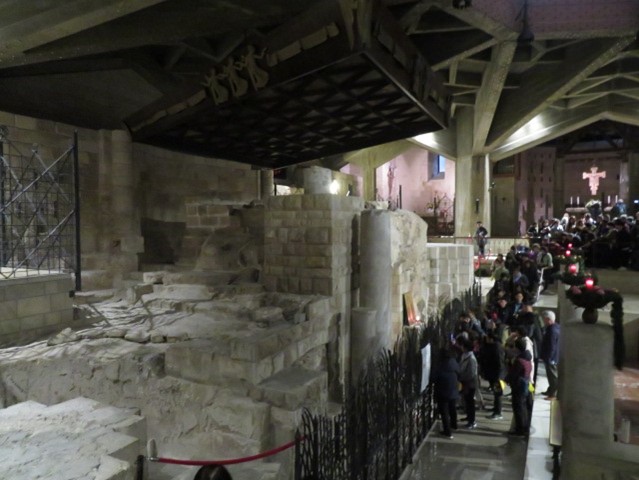

(photos: SMRP)
There are also the ruins of a synagogue-church, the first building erected close to the sacred Grotto. It was frequented by Judeo-Christians and built before the 5th century. Scratched on the base of a column are the Greek characters XE MAΡIA. Fleshed out, they are “ΧΑΙΡΕ ΜΑΡΙΑ” which means “Hail, Mary.” Now Luke reports in his gospel (1:28) that the Angel Gabriel entered and said to her, “Hail, Full of Grace, the Lord is with you.” He did not use the name of Mary, but called her Full of Grace. The Church, however, has inserted the name of Mary into the prayer.
Now let us move up the street to the Church of St. Joseph which was built in 1914. In 1950 the apses of the church were done in frescoes by A. Della Torre: The Holy Family, St. Joseph’s Dream, St. Joseph’s Death. The house and workshop of St. Joseph were believed to be beneath the church. Going down to the level of the house/workshop of Joseph, we will see in front of the altar a small disk of porphyry, around which runs the words: hic erat subditus illis. Here He was submissive to them. Here Jesus was submissive to his parents when they went down to Nazareth after the Finding in the Temple (Luke 2:51).
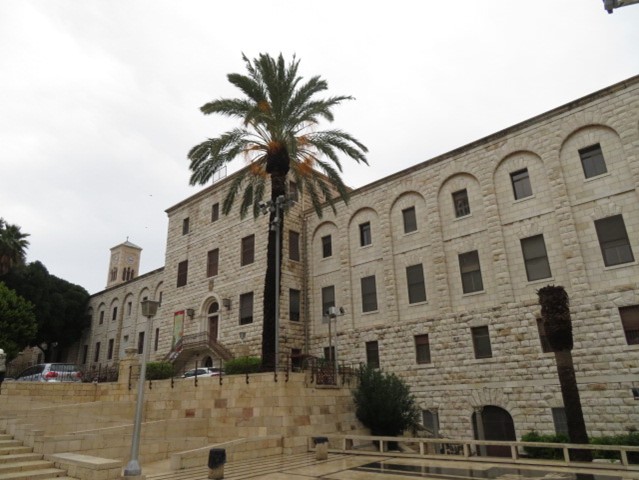

(Left photo: SMRP: facade; Right photo: SMRP: apse: Holy Family)
The space speaks of the harmony of family life; that is, the Holy Family shows us the beauty of the Fourth Commandment: “Honor your father and mother, that you might have long life in the land that I am giving you” (EX 20:12). This place is meant to be a prayerful place, a place where we give thanks for the example of the Holy Family.
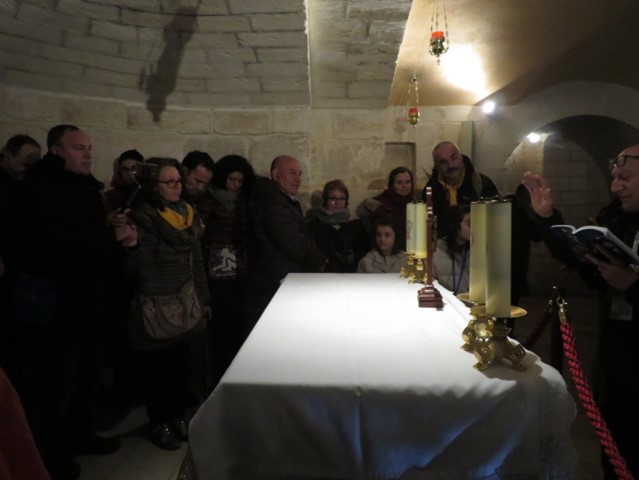
(photo: SMPR: We pilgrims around altar of chapel below Church of St. Joseph)

(photo: SMRP: “Here He was submissive to them.”)
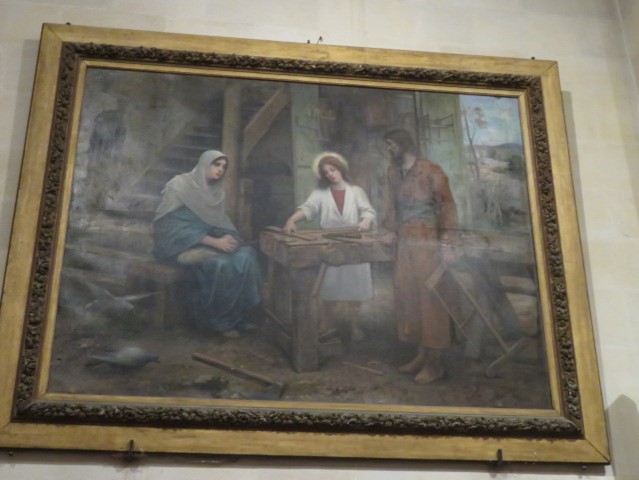
(photo: SMRP: Picture of the Holy Family hanging in the area beneath the Church of St. Joseph)
POINTS OF REFLECTION:
*The Annunciation and Incarnation of the Son of God is a most wonderful and extraordinary event. It is the mystery of the enormous love God has for mankind. It took place in Nazareth, a tiny village in a country that was hardly known to the outside world of its day. There God took on the perfect and entire nature of man, preserving the totality of His divine essence and assuming the totality of our human essence (cf. Heb. 10:5-7). Such was His love and humility and desire to do the Will of the Father.
Mary, the Virgin of Nazareth possessed profound faith, a deep love, and the gifts of the Holy Spirit, and this is why she understood the message of the Angel. Each of us has experienced an annunciation or two in our lives in which the Lord was asking us to do the Will of the Father. Let us recall those times, and ponder the mystery of God’s love for us in asking us to give our “Yes,” our Fiat, to Him.
*As the Angel said to Mary, “Do not be afraid,” so the Lord is saying the same to us, “Do not be afraid” of assuming this or that responsibility, of helping our neighbor, our Sister, of being sick, of growing old, of… What do I fear? Let us ask Mary to intercede for us that we may lovingly assume whatever God is asking.
*As Christ was obedient not only to His Father, but also to His creatures, let us renew our Vow of Obedience. We read in Perfectae caritatis, 14: “Religious, moved by the Holy Spirit, subject themselves in faith to those who hold God’s place, our superiors. Through them they are led to serve all our brothers in Christ.” Am I striving to say “yes” to the Will of God manifested through my superior?
